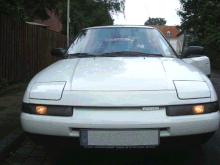Pop-up headlights

Pop-up headlights , also known colloquially as sleeping eyes , are front headlights that are recessed or covered when they are switched off.
history
The first mass-produced automobile with pop-up headlights was the Cord 810/812 introduced in 1935 . He used headlights that were manufactured by Stinson Aircraft and were originally used as retractable landing lights in aircraft.
Equipping sedans with pop-up headlights only became popular in the United States , where aerodynamic glass covers were not permitted in front of the headlights from 1968 to 1983. Elsewhere, sports cars were typically equipped with such headlights. They made it possible to design the front section in such a way that it is aerodynamically particularly favorable as long as the headlights are not needed - but at the price, the less wind slippage when the headlights are switched on. This means that pop-up headlights in countries that require daytime running lights are not aerodynamically sensible.
In addition, there is a special situation with the high beam in vehicles with pop-up headlights ; in normal operation during the day (when the headlights are closed) you cannot flasher or you have to accept a long delay before the headlights open up to give a light signal. Since this is extremely impractical and can cause difficulties with approval in individual cases, z. B. in the BMW 8 Series (E31) two pairs of high beams. In addition to the high beam for permanent operation (which is located in the pop-up headlight), a second pair of high beam was placed in the bar next to the indicator. This secondary high beam is also visible when the folding headlight is retracted and is used to emit light signals.
Since the criteria for pedestrian protection have become stricter and new types of lighting technology have made smaller headlights possible, pop-up headlights have rarely been installed. In 2004, the production of the last three vehicles with pop-up headlights, the Corvette C5 , the Lotus Esprit and the De Tomaso Guarà , stopped.
Types and technology
There are various basic principles according to which pop-up headlights are implemented in automobiles:
- Recessed with rotation around the transverse axis : when the headlights are switched on, electric motors move them out of the body. This solution is found most often, for example in the Porsche 914 . On a few models such as the Lamborghini Miura or Porsche 928 , the pop-up headlights are visible even when they are switched off and then point upwards. The opening angle ranges from around 20 ° on the first BMW 8 Series to around 180 ° on the Chevrolet Corvette C4.
- Recessed with rotation around the longitudinal axis : This solution is found in the Opel GT , where the headlights are not extended electrically but by hand.
- Concealed : In vehicles like the Lincoln Continental , the headlights are fixed. Their covers are driven under the body electrically or with negative pressure. While this does not cause any aerodynamic change on the Lincoln, on the Jaguar XJ220 and Vector W8 two recesses open by lowering the body panels in front of the headlights.
Before the introduction of polyellipsoid headlights (in the 1980s), pop-up headlights were a compromise solution to accommodate large headlights in very sporty motor vehicles. When the headlight is used, the average value deteriorates by 3 to 10 percent.
See also
Web links
Footnotes
- ↑ e31.net: Illustration of the lighting units of the BMW 8 series
- ↑ Olaf von Fersen (ed.): A century of automobile technology. Passenger cars. VDI Verlag 1986, ISBN 3-18-400620-4 , p. 316.
- ↑ Michael Trzesniowski: racing car technology . 2nd Edition. Vieweg + Teubner, Wiesbaden 2010, ISBN 978-3-8348-0857-8 , p. 129

